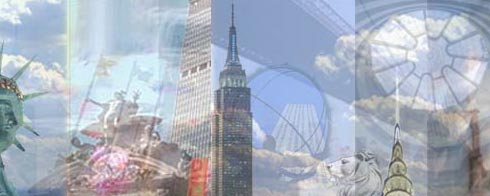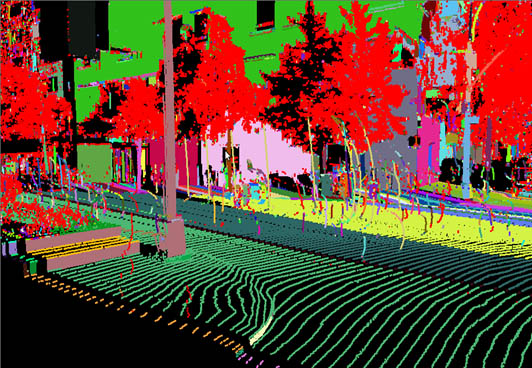
Figure: (a) 3D range scan of
Park Avenue and 70th street (scanner is a the center of the
intersection). Bird's-eye view. Data gathered by the Leica
ScanStation2 of our laboratory. (b) 3D texture-mapped model of
building at CCNY. Camera positions are shown . (c) Online
classification of objects in urban scene.
Course Overview
Recent advances in computer hardware have made possible the
efficient rendering of realistic 3D models in inexpensive
PCs, something that was possible with high end visualization
workstations only a few years ago. This class will cover the field
of 3D Photography -the process of automatically creating 3D
texture mapped models of objects- in detail. We will concentrate on the topics at the
intersection of Computer
Vision and Computer Graphics that are relevant to
acquiring, creating, and representing 3D models of small objects
or large urban areas. Many very interesting research questions
need to be answered. For example: how do we acquire real shapes?
how do we represent geometry? can we detect similarities between
shapes? can we detect symmetries within shapes? how do we register
3D geometry with color images?, etc. Applications
that benefit by this technology include: image retrieval in digital libraries,
image search, face recognition, historical
preservation, urban planning, 3D maps, autonomous navigation,
virtual reality, augmented reality, e-commerce, digital
cinematography, computer games, just to name a few.

Course
Format
There will be a weekly class, with presentations by the
instructor.
The grade will
be based upon the following: 40% homework &
programming assignments, 20% midterm exam, 40% final project (1-3 students per group).
Prerequisites
Linear algebra, data structures and algorithms,
and C/C++ or Java programming. No prior knowledge of vision
is assumed. Courses such as image processing, computer graphics, and digital tomography are helpful
but are not required for the understanding of the material.
Topics
- Image formation and perception, image representation.
- 2D and 3D sensors (digital cameras and laser range scanners).
- Image filtering: space- and frequency- domain filtering,
linear and non-linear filters.
- Edge detection, image segmentation, active contours, level set
methods.
- Camera calibration.
- Object recognition, template matching, classification
- 3D- and 2D- image registration.
- Camera models, stereo vision.
- Optical flow.
- Segmentation.
- 3D point cloud
processing.
-
Course Material

This class will be based on
recent publications and recent workshops. A set of seminars,
books, and journals are provided for your reference.
Computer
Vision Books:
Computer Vision: Algorithms and Applications, Richard
Szeliski, 2010: Online Version
Introductory Techniques for 3-D Computer Vision.
EmanueleTrucco and Alessandro Verri. Prentice Hall, 1998.
Robot Vision. B. K. P. Horn, The MIT Press, 1998 (12th
printing).
Computer Vision A Modern approach.
David
S. Forsyth, Jean Ponce. Prentice Hall 2003. Some
online content.
Three-Dimensional Computer Vision: A Geometric Viewpoint.
Olivier Faugeras, The MIT Press, 1996.
An Invitation to 3-D Vision. Yi Ma, Stefano Soatto, Jana
Kosecka, S. Shankar Sastry. Springer-Verlag, 2004.
Computer Vision. Linda Shapiro and George Stockman. Prentice
Hall, 2001.
Computer
Graphics Books:
Computer
Graphics, Principles and Practice. Foley, van Dam, Feiner,
and Hudges. Addison-Wesley, 1997.
3D Computer Graphics. Alan Watt. Addison-Wesley,
2000.
OpenGL Programming Guide. Mason Woo, Jackie Neider,
Tom Davis. Addison-Wesley, 1998.
Computer Vision and
Graphics Journals/Conferences:
Open
access computer vision papers.
International Journal on Computer Vision.
Computer Vision and Image Understanding.
IEEE Trans. on Pattern Analysis and Machine Intelligence.
SIGGRAPH
(http://www.siggraph.org).
Libraries:
OpenCV library




